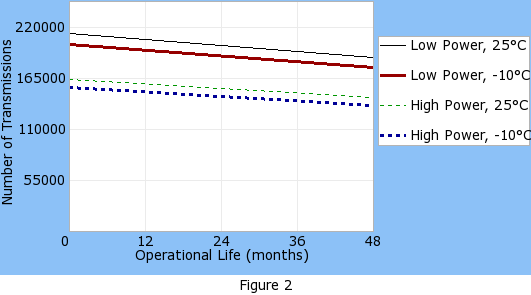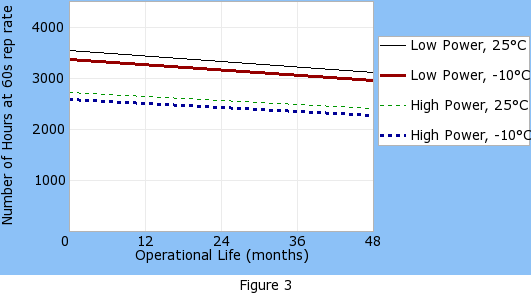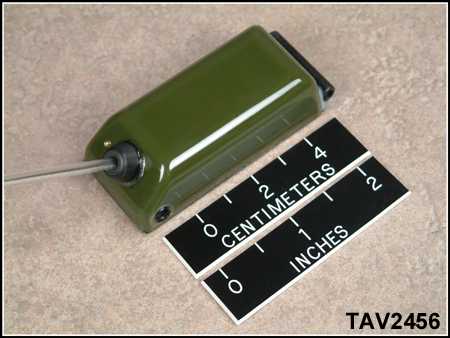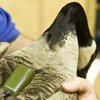TAV-2456 Argos Transmitter
The information below on discontinued products is provided for individuals who are still using these older systems. Product descriptions may be time sensitive or even outdated. Please contact Telonics if you have questions.
| Dimensions L x W x H (in, cm) |
Unit Weight
(g) |
Low power
(mW) |
Low power
life (hours)1 |
Low power
temp (°C) |
High power
(mW) |
High power
life (hours)1 |
High power
temp (°C) |
2.65 x 1.28 x 0.80 in
6.7 x 3.3 x 2.0 cm |
60 |
160 (Typ) |
3589 |
-10 to +60 |
250 (Typ) |
2770 |
-10 to +60 |
Telonics designed the model TAV-2456 specifically for avian applications. This model is well suited for deployment on larger species and the larger battery pack makes multiyear deployment possible. The battery system used in this model is considered nonhazardous allowing shipment by standard methods throughout the world.
Key Features
- Capable of operating for several years.
- Operational life is extended by a factor of three relative to older transmitter models, due to ultra-low quiescent current and highly efficient radio transmission circuitry.
- Real-time clock calendar (RTC) controls all timing functions.
- Powerful data collection and transfer capabilities allow the units to acquire, queue, and transmit temperature and activity information.
- User programmability allows researchers to reprogram units in the field and change their role and mission.
- On-board sensors can be activated or deactivated in the field. Data collection regimes and schedules can be altered as required. Sensor data can be enhanced or deleted from Argos uplink transmissions.
- Transmission schedules can be modified.
- Argos ID codes can be changed.
- Argos uplink transmission power levels can be modified to extend operational life or increase the probability of signal reception at the satellite.
- Argos uplink frequencies can be changed to frequencies in low noise channels to increase the chances of a successful uplink.
- Units can be refurbished to their original condition at the factory.
- Using a small magnet, users can turn a unit "on" or "off". When turned "off", this model consumes less than 4 μA. Given this low quiescent current level, users can store their units for extended periods with minimal impact on operational life.
- The antenna design incorporates an advanced stress relief at the base that minimizes breakage.
Operational Life Information

The graph provides a means to evaluate the total number of 4-byte Argos messages that can be transmitted (or "uplinked") by the TAV-2456 given a specified operational lifetime. Both low power and high power operational life predictions are shown for comparison. The transmissions can be scheduled as per user requirements using the TAV-2456 scheduler. The repetition rate, daily and seasonal duty cycles can be modified as required to meet study design. Modifications of these operational parameters can be made at the factory or by the researcher using the Telonics Product Programmer (TPP).

This graph is related to the one shown above. The graph provides a means to evaluate the total number of hours a 4-byte Argos message can be transmitted (or "uplinked") by the TAV-2456 given a specified operational lifetime. Both low power and high power options are shown for comparison. The hours of transmission can be scheduled as per user requirements. The Argos repetition period used to generate this graph is 60 seconds. Daily and seasonal duty cycles can be modified as required to meet study design. Modifications of these operational parameters can be made at the factory or by the researcher using the Telonics Product Programmer (TPP).
Programmable Features
The TAV-2456 can be fully programmed at Telonics per the user's instructions so it arrives ready for deployment. Alternatively, researchers can choose to construct the data collection scheme and transmission parameters at their laboratory. Field programming the TAV-2430 can be done at any time prior to deployment.
TPP, the Telonics Product Programmer, is a software utility that allows the user to customize and program the unit's role and mission. The TPP demonstration software allows researchers to evaluate programming functions and data collection capabilities for all supported transmitter models for 30 days. The demonstration version of TPP is fully functional with the exception that it does not support actual programming of hardware. Users can purchase the "software key" to convert their demo version into a fully operational program.
Programmable Transmission Parameters
- ID code: Any valid 20-bit or 28-bit Argos ID code
- Repetition period: 5 to 3600 seconds, as authorized by Argos
- Seasons: Up to 32 intervals of time (1 day to 100 years, in 1 day increments) in which on periods occur
- Frequency: 401.618 MHz to 401.680 MHz, as authorized by Argos
- Transmission power level of 160 mw or 250 mw
Note: The Argos system was originally designed to support 1 watt transmitters with antenna gain levels of 0dbd typically used in oceanographic applications, More sensitive Argos receivers on the board the newer NOAA satellites have promoted the use of lower power transmitters with the same link margin as the older more powerful transmitters. The power level of the ST-24 Argos Transmitter can be selected using the programming utility TPP. The unit supports two power options. The most commonly selected option is the 250 mw power output level. This level has been successfully used for many avian applications and is the level that Telonics recommends for most deployments. Under special circumstances (i.e. in extremely low noise environments and with a good transmitting antenna configuration) the160 mw power level can be used. However the user is cautioned to test the unit extensively in the region where the unit is to be deployed to be sure that the lower power level is adequate to maintain the link to the satellite in their application. The user should be aware that there are regions in the world (i.e. Europe and the middle east) with higher then average noise levels and under these conditions lower power levels may not provide enough uplink messages to assure an Argos position determination. Testing is the key to successful deployments particularly using lower power levels.
Sensors and Data Collection Programming
Temperature Sensor: Measures temperature between -40 to +70°C, ±1°C (typical) accuracy.
Low Voltage Sensor: Determines the battery condition by measuring the battery voltage during transmission.
Activity Sensor: Determines animal activity level based on animal movement measured within a specified interval.
Mortality Sensor: Infers whether or not the animal is dead by comparing the animal activity level to a specified threshold.
Configuration Options
Color Options
Option 101: Olive drab Green (standard if not designated)
Option 102: Black
Option 103: White
Option 104: Yellow
Application and Attachment Notes
Various attachment techniques have been used to deploy telemetry units on birds. The selection of the appropriate material and the specific designs of the attachment should be made by consulting with researchers who have successfully applied telemetry to the subject species in the past, with agencies responsible for permitting telemetry applications, and with appropriate individuals responsible for animal care and handling. Additionally, there is a large body of biological literature in journals and on websites addressing this topic. In some cases, extensive scientific papers on methodology exist and should be reviewed. In some papers, techniques are compared; problems and preferred techniques are identified. Even after extensive literature review, subtleties exist in the application of all these techniques that are difficult to describe in the literature. For example, it is difficult to describe exactly how tight to apply or cinch a harness. Actual "hands on" experience is often an important element to successful instrumentation. Directly below is a listing of attachment techniques used successfully in the past, some comments about each technique, and list of materials that Telonics has available for purchase.
Backpack Harnesses
Backpack harnesses are designed to position the Argos transmitter on the back of the bird between the wings. These harnesses generally work into the feather tracks and are secured on the breast. Various harness materials have been used including but not limited to soft leather strap, elastics or bungy cord, and 1/2- or 1/4-inch Teflon ribbon. The following backpack harness materials are available from Telonics.
Teflon Ribbon Harness Materials
MT-000555-001 Teflon ribbon harness material for small-bodied birds. Width: 0.25" (0.64 cm) Weight: 1.5g/foot. Priced per foot.
MT-000684-002 Teflon ribbon harness material for large-bodied birds. Width: 0.5" (1.3 cm). Weight: 3.0g/foot. Priced per foot.
Elastic Harness Materials
MT-000684-001 Elastic ribbon harness material for small birds. Width: 0.125" (0.32 cm). Weight: 0.5 g/foot. Priced per foot.
MT-000684-002 Elastic ribbon harness material for small birds. Width: 0.25" (0.64 cm). Weight: 1.0 g/foot. Priced per foot
Aprons, Bibs, and Panchos
Aprons, bibs, and ponchos are designed to mount the transmitting subsystem on flat durable material such as "herculite". A hole is cut into the material to allow the bird's head to fit through; the material and the system is then draped over the neck. This kind of mount is often used successfully with Gallinaceous birds that be adversely impacted by a backpack harness. The antenna is dressed along the material and exits past the neck and then drapes over the back of the bird.
Necklaces
Necklaces are designed to be similar to apron mounts; however, the material used may make the final assembly more closely resemble a collar. In general, the necklace holds the transmitter closer to the neck as compared to an apron mount.
Patagial Mounts
Patagial mounts are designed such that the transmitting unit is on the wing of the bird. This technique is typically used on large, strong birds that soar such as vultures. The transmitter is glued or tied with suture to a soft durable strip of material such as "herculite". The material is wrapped around the patagium and riveted or glued. The transmitter is thereby positioned on the dorsal surface of the wing. The antenna is in the same orientation as the primary feathers. Neckbands are designed to mount the Argos transmitter on a standard-colored plastic neck band. These bands are used routinely by the federal and state agencies to color mark and number waterfowl. They are coiled and expand to fit around the neck. No fastener is used. Typically the antenna is glued to the plastic band in a manner that allows the antenna to be exited on the dorsal surface of the neck. A section of exposed antenna is often necessary to maintain the link with the satellite and this section of antenna is always more subject to damage/breakage then the portion of the antenna glued directly to the plastic band. If the external portion of the antenna is broken the link to the satellite can be lost. These bands are not available from Telonics and must be procured and provided by the researcher at time of order. There is a charge for mounting the unit on the band.
Legbands
Legbands are similar to the neckbands described above, but they tend to be smaller in diameter. Legbands are often used to mark long legged wading birds. They are typically mounted high on the leg and actually rest on the "knee". Weight is important because units that are too large can cause the band to wear against the skin of the knee joint. The exposed antenna is easily accessible by the bird and is therefore subject to preening and possible damage. As a final note, the antenna is positioned in a place where it may be submerged in the water and the link to the satellite is lost during this time period. These bands are not available from Telonics and must be procured by the researcher. There is a charge for mounting the unit on the band.
Tail Mounts
Tail mounts are used to directly attach the transmitting unit to one or two deck feathers of the bird's tail. This technique has the great advantage of using the natural molt of the bird's tail feathers as a breakaway mechanism. The units must be placed on hard pinned feathers and the antenna is often tied with surgical suture to the feather shaft. Clearly, timing of the attachment relative to the molt is an important consideration. Although the double feather mount is more stable and distributes the weight of the configuration over two feathers, there is always a concern that one feather will likely molt before the other, leaving the transmitting unit dangling from the remaining feather until it breaks at the shaft or pulls out.
Glue
Gluing the unit directly to the skin of the bird involves the use of cyanoacrylic glues (super glue). This technique minimizes the weight of the final configuration. There are no additional materials like harness material to contribute to the total weight of the final system. It should be noted that some bird species will remove a glued unit within a short time period.
Implantation
Implantation is a technique used to place the transmitting unit in the body cavity of the bird. The unit is coated in a physiological wax to minimize immunological reactions. This technique has the advantage that the unit is near the center of gravity: like a glued unit, there is no additional weight contributed by attachment devices. In species that do not wear external devices well, this may be the only practical means to instrument the animal. Unlike VHF telemetry implants, the technique is complicated by the need to exit the Argos antenna out of the body cavity in order to achieve a successful link to the satellite. The technique usually involves having the surgical implantation process done by a veterinarian that specializes in birds. This technique has been used successfully in the instrumentation of several species of sea ducks.
Specifications
Mechanical
| Size | 2.65 x 1.28 x 0.80 in
6.7 x 3.3 x 2.0 cm |
|---|
| Weight | 60 grams |
|---|
| Antenna Length | 8.0 in
203 mm |
|---|
Electrical
| Electronics | ST-24 |
|---|
| Power Source | Lithium Cell |
|---|
| Low Power Level | 160 (Typ) mW
22 ±2 dbm |
|---|
| Low Power Life | 3589 hours |
|---|
| Low Power Operating Temperature | -10 to +60 °C |
|---|
| High Power Level | 250 (Typ) mW
24 ±2 dbm |
|---|
| High Power Life | 2770 hours |
|---|
| High Power Operating Temperature | -10 to +60 °C |
|---|
| Argos Transmission Frequency | 401.618 to 401.680 MHz |
|---|
| Modulation (BPSK) | -1.1 to +1.1 ±0.1 radians |
|---|
| Quiescent current (typical) | 3 µA |
|---|
| Spurious emissions | -45 dB |
|---|
1. Operational life expectancy is based on a continuous series of transmissions of a 4-byte Argos message at a 60-second repetition rate at 25°C.
Photo Gallery
Related Products
Related Software
Technical Notes
Related Links to Information on Other Websites
Service Commitment
Since 1970, Telonics has built a reputation based on product quality, product support, service, and customer satisfaction. Telonics strives to produce the highest quality products, and to support those products accordingly.
Because of extreme conditions and the unpredictable nature associated with most telemetry applications, problems occasionally arise. Most problems can be resolved quickly. In all cases, we hope to be able to work in partnership with users to resolve problems to the user's satisfaction and to uphold our demonstrated commitment to excellence. If problems should arise, all products must be returned to our factory for failure analysis.
Warranty: Argos Systems - Show
Telonics warrants its Argos products to be free from defects in material and workmanship for a period of one year from the date acquired. Telonics does not warrant batteries.
If a defect occurs, return the equipment to us within the proper time frame at the following address: TELONICS, 932 E. IMPALA AVENUE, MESA AZ USA 85204-6699. The customer shall arrange for and pay all shipping, insurance and related charges incurred in the shipment to and from Telonics under this warranty. Damage to any equipment resulting from misuse, accidents, unauthorized service, extreme conditions, or other causes, is excluded from this warranty. Telonics does not assume responsibility for loss or damage to equipment during shipment. Telonics does not assume responsibility for delays resulting from shipment on commercial or private carriers. We insure all equipment shipped from our facility and suggest that shipments to Telonics also be insured.
Upon the timely return to our facility, if defective, the product will be replaced or repaired at our discretion at no cost to the customer. This remedy is the exclusive remedy. This product is supplied without any further warranties or conditions, expressed or implied, including warranties of merchantability, quality or fitness for particular reason or those arising by laws, statutes or trade usage or course of dealing.
The entire risk, as to the results and performance of the product, is assumed by the customer. Neither Telonics, nor its suppliers, shall have any liability to the customer or any other person or entity for any indirect, incidental, special, or consequential damage whatsoever, regardless whether Telonics has been told of the possibility of such damages or that such damages might be foreseeable. Telonics has no responsibility or liability for the claims of any third party. The maximum aggregate to the customer, of Telonics and its suppliers, shall not exceed the amount paid by the customer for the product.




